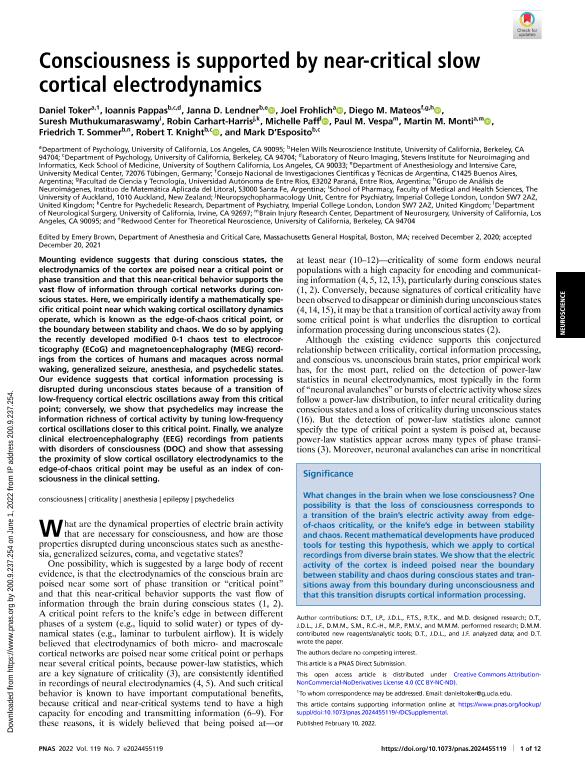Mostrar el registro sencillo del ítem
dc.contributor.author
Toker, Daniel
dc.contributor.author
Pappas, Ioannis
dc.contributor.author
Lendner, Janna D.
dc.contributor.author
Frohlich, Joel
dc.contributor.author
Mateos, Diego Martín

dc.contributor.author
Muthukumaraswamy, Suresh D.

dc.contributor.author
Carhart Harris, Robin
dc.contributor.author
Paff, Michelle
dc.contributor.author
Vespa, Paul M.
dc.contributor.author
Monti, Martin M.
dc.contributor.author
Sommer, Friedrich T.
dc.contributor.author
Knight, Robert T.
dc.contributor.author
D’Esposito, Mark
dc.date.available
2023-02-04T02:13:24Z
dc.date.issued
2022-02
dc.identifier.citation
Toker, Daniel; Pappas, Ioannis; Lendner, Janna D.; Frohlich, Joel; Mateos, Diego Martín; et al.; Consciousness is supported by near-critical slow cortical electrodynamics; National Academy of Sciences; Proceedings of the National Academy of Sciences of The United States of America; 119; 7; 2-2022; 1-12
dc.identifier.issn
0027-8424
dc.identifier.uri
http://hdl.handle.net/11336/186875
dc.description.abstract
Mounting evidence suggests that during conscious states, the electrodynamics of the cortex are poised near a critical point or phase transition and that this near-critical behavior supports the vast flow of information through cortical networks during conscious states. Here, we empirically identify a mathematically specific critical point near which waking cortical oscillatory dynamics operate, which is known as the edge-of-chaos critical point, or the boundary between stability and chaos. We do so by applying the recently developed modified 0-1 chaos test to electrocorticography (ECoG) and magnetoencephalography (MEG) recordings from the cortices of humans and macaques across normal waking, generalized seizure, anesthesia, and psychedelic states. Our evidence suggests that cortical information processing is disrupted during unconscious states because of a transition of low-frequency cortical electric oscillations away from this critical point; conversely, we show that psychedelics may increase the information richness of cortical activity by tuning low-frequency cortical oscillations closer to this critical point. Finally, we analyze clinical electroencephalography (EEG) recordings from patients with disorders of consciousness (DOC) and show that assessing the proximity of slow cortical oscillatory electrodynamics to the edge-of-chaos critical point may be useful as an index of consciousness in the clinical setting.
dc.format
application/pdf
dc.language.iso
eng
dc.publisher
National Academy of Sciences
dc.rights
info:eu-repo/semantics/openAccess
dc.rights.uri
https://creativecommons.org/licenses/by-nc-sa/2.5/ar/
dc.subject
ANESTHESIA
dc.subject
CONSCIOUSNESS
dc.subject
CRITICALITY
dc.subject
EPILEPSY
dc.subject
PSYCHEDELICS
dc.subject.classification
Otras Ciencias Físicas

dc.subject.classification
Ciencias Físicas

dc.subject.classification
CIENCIAS NATURALES Y EXACTAS

dc.title
Consciousness is supported by near-critical slow cortical electrodynamics
dc.type
info:eu-repo/semantics/article
dc.type
info:ar-repo/semantics/artículo
dc.type
info:eu-repo/semantics/publishedVersion
dc.date.updated
2023-02-02T23:23:41Z
dc.journal.volume
119
dc.journal.number
7
dc.journal.pagination
1-12
dc.journal.pais
Estados Unidos

dc.journal.ciudad
Washington
dc.description.fil
Fil: Toker, Daniel. University of California at Los Angeles; Estados Unidos
dc.description.fil
Fil: Pappas, Ioannis. University of California at Berkeley; Estados Unidos. University of Southern California; Estados Unidos
dc.description.fil
Fil: Lendner, Janna D.. University Medical Center; Alemania. University of California at Berkeley; Estados Unidos
dc.description.fil
Fil: Frohlich, Joel. University of California at Los Angeles; Estados Unidos
dc.description.fil
Fil: Mateos, Diego Martín. Universidad Autonoma de Entre Rios; Argentina. Grupo de Análisis de Neuroimágenes; Argentina. Consejo Nacional de Investigaciones Científicas y Técnicas; Argentina
dc.description.fil
Fil: Muthukumaraswamy, Suresh D.. University of Auckland; Nueva Zelanda
dc.description.fil
Fil: Carhart Harris, Robin. Imperial College London; Reino Unido
dc.description.fil
Fil: Paff, Michelle. University of California at Irvine; Estados Unidos
dc.description.fil
Fil: Vespa, Paul M.. University of California at Los Angeles; Estados Unidos
dc.description.fil
Fil: Monti, Martin M.. University of California at Los Angeles; Estados Unidos
dc.description.fil
Fil: Sommer, Friedrich T.. University of California at Berkeley; Estados Unidos
dc.description.fil
Fil: Knight, Robert T.. University of California at Berkeley; Estados Unidos
dc.description.fil
Fil: D’Esposito, Mark. University of California at Berkeley; Estados Unidos
dc.journal.title
Proceedings of the National Academy of Sciences of The United States of America

dc.relation.alternativeid
info:eu-repo/semantics/altIdentifier/url/https://www.pnas.org/doi/10.1073/pnas.2024455119
dc.relation.alternativeid
info:eu-repo/semantics/altIdentifier/doi/http://dx.doi.org/10.1073/pnas.2024455119
Archivos asociados
